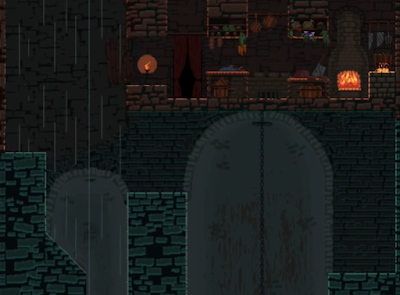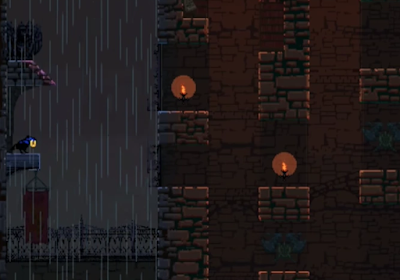You may have heard of "Foddian Games" like Getting Over It or Jump King (named after Bennet Foddy, the creator of Getting Over It). What makes these games unique is that they push you into situations where you have to risk losing all your progress and starting again from scratch. They are deliberately frustrating, but also very satisfying to master.
In Jump King, you leap upwards, propelled by rumours of a smokin' hot babe at the top. Each time you jump, you risk losing your progress and tumbling all the way back to the start of the game. As you leap higher, you meet ruined and broken men, their legs shattered. Seek not the babe, they tell you. She must be only an illusion. A hopeless fantasy. No man can make those jumps and live.
One of the things that makes this interesting is the way it plays with risk and reward. You have safe areas that act like checkpoints. This area with the fireplace is one example. The floor is solid, so you won't lose your progress if you fall. Reaching this area is really satisfying, and this space feels safe and warm.
If you want the coin this crow is carrying, you have to leap out of your safe zone, into the rain. You run the risk of falling way down, past your safe area, into the drain, losing a whole heap of progress. Can you take the risk? This creates a huge feeling of tension and danger.
So I wonder - could we make a fun Foddian dungeon?
The Tower Of Babel
The wretched fools tried to make a tower to reach God. Some even say they succeeded. Either way, they were struck down and scattered, turned into all manner of hideous beasts, their language split into many tongues so that they could never dare their hubris again. Now desperate men and heathens return to the ruins of that tower, seeking treasure - and perhaps even the fabled Door to Heaven.
It's a vertical dungeon with a complete and total focus on traversing the environment. Your goal is to get as high as you can. The dungeon is all about climping the walls, swinging on the chandeliers, dangling from grappling hooks, balancing on the rafters, tiptoeing around rotten floors, finding ladders and ropes and secret passages that lead higher. Ultimate verticality.
The monsters, obstacles and traps are all designed to feed into the environment. It's not about fighting the monster in a blank room. Instead, the monster is designed to force you to interact with the environment in an interesting way to avoid it or deal with it. The envrionment is the star, the monsters are the supporting cast.
As you get higher and higher, at some point you're going to fall down. Let's say an NPC at the bottom sells Feather Fall charms that each activate once, so you won't die from the fall. This means you're going to fall back down and be forced to go through the dungeon again and again, slowly mastering the environment and learning shortcuts and clever pathways to get higher and higher.
XP for gold would be a must here. The more treasure you get, the more you're weighed down, the more likely it is for you to slip and fall to the bottom. Risk / reward. Perhaps if you fall, you have a chance to lose some of your treasure and suffer injuries (sprains, broken limbs, etc).
Mutations
Of course we need to keep things interesting as the players go through the same room multiple times. Each room will need to be dense and packed with secrets that the players are unlikely to discover the first time through. Shortcuts would of course be a key focus - tons of secret doors and ways to unlock new pathways through the dungeon. Doors that are only barred on one side, for example.
But let's push the replayability of each room even higher by adding 2-3 mutations for each room. Each mutation is a change that puts a new spin on the location. The DM can add the mutations in whenever the players revist a room, or whenever they feel like it needs a new coat of paint.
Here's a rough example how I see the rooms looking. The art would be a 2D, side-on view of the room.
Dining Hall
Black grime and mildew streaks the once-great hall.
- Long dining table stretches across the entire room. Still sturdy.
- Chairs scattered across the floor. Tall chair at the head of the table has a secret compartment in the arm with 1d6 doses of scorpion venom (save or paralyse).
- Giant portrait of Lord Ashbury on the north wall. A bearded man with golden clothes and hollow eyes, shown seated in the Gardens (p.34).
- A secret passage behind the portrait leads up to the Gardens (p.34). You can see through small slits in the painting. Lord Ashbury used it to spy on his guests.
- 2 chandeliers above. You can reach them with a jump from the table, and swing on them to reach a high window leading to the Roof (p. 23).
- Each chandelier has a 50% chance of falling when weight is placed on it.
- 1 lava glazed bone glass candle (100gp) in a socket of a chandelier.
- Large hidden patch of rotten floorboards in center of the room, fall away if weight is put on them.
- Walking on top of the dining table avoids the rotten floorboards.
- 50gp in silverware embedded in grime in the center of the rotten floorboards, underneath the table.
- Giant cobwebs everywhere. Touching the webs alerts a giant spider on the roof (p. 34). 1d6 captured children from town struggle in webbed cocoons on the chandeliers.
- Fungal anarchy. White puffball mushrooms float slowly through the air. On touch, they explode and cause you to hallucinate for d4 rounds. You see the room in its former glory, 2,000 years ago. All enemies and NPC's appear as friendly lords and ladies.
- Ghost party. The ghosts of Lord Ashbury and other nobles float through the room. Conversation is heard as a dim murmur. The ghosts do not notice you. Any body part that moves through a ghost shrivels and ages (withered limb becomes unusable for 1 day).
On top of this you'd add the classic wandering monsters. Every 10 minutes, you roll 1d6 to see if any monsters show up. You would need to move through the environment as quickly as possible to avoid monsters. The monsters would act as pressure to force you to interact with the environment in interesting ways (like leaping for the chandeliers to escape them).
The encounter table itself would have coloured sections for mutations, so you can mix it up. It would look a little like this.
1. 2d4 Cursed Beasts. | 2d4 spiderlings. | Lord Ashbury's Ghost.
When you roll this entry, you can choose the normal monsters, or one of the mutations.
Monster Mutations
Strengths
- The PC they defeated must save when they see them, or be forced to retreat in a panic.
- They now have a spell known to one of the PC's they defeated.
- They know your tricks. They take half damage from a specific source (eg, damage from ranged attacks, damage from melee attacks, magic, etc).
- They have advantage to save against your spells.
- They're swole now. When they attack you, you must save or be sent flying back and fall prone.
- They deal +d6 damage in situations that match how they last defeated you (eg, to long range attacks).
- They get advantage to checks to pick up, grapple and throw PC's around, and they can do it as a bonus action on their turn.
- They now have bombs that send out clouds of poisonous gas (d6 damage a turn while in the gas).
- Acid bombs. Save or your shield or armour is destroyed.
- They have a mechanical grappling hook arm now. They get advantage to checks to swing around and do acrobatic things, which they can do as a bonus action on their turn.
- They have recruited 2d6 minions (the minions have their stats and abilities, but die in 1 hit).
- Unstoppable determination. The first time they fall to 0 HP, they fall to 1 HP instead. They get advantage to all rolls while at 1 HP.
Weaknesses
- Overwhelmbed by hatred for the PC that defeated them. They will rush that PC and make foolish decisions.
- Fear of the thing that defeated them (eg, heights). Must save or panic when confronted with that thing.
- Old wound. Takes double damage from a specific source (ranged attacks, fire, magic, etc).
- They have disadvantage to spell saves.
- They're missing a foot. They suffer disadvantage to checks to leap, jump and do acrobatic things.
- They're missing a hand. They can only wield 1-handed weapons.
- They're missing an eye. They have disadvantage to perception checks and are easily surprised.
- They're missing their friends. They must save or be stunned for a round if you mention any old allies of theirs who died.
- They're suffering from ennui and low morale. They roll morale checks -2 and are likely to give retreat.
- They have become obsessed with the PC's. They miss meals and sleep obsessively planning ways to get back at them. They're exhausted and have half speed.
- They sold their soul to get a chance at revenge. They must fulfil a demonic bargain (eg get a certain amount of treasure / souls) or be dragged to hell.
- They are slowly dying. They lose 1 HP each round.
The Town
Prince Braffington. Arrogant, charming, engages in a light-hearted rivalry with the PC's, laughs that he will reach the top in 20 minutes. Maybe he gives the PC's some small help or hindrance before using his grappling hook to swoop ahead of them.
Each time they see him, he has grown much older. Time and space distorts the closer you get to the top. For him, 20 years has passed, but you haven't aged a day. He withers, his limbs broken, yet as long as his heart beats, he will climb higher. The honour of the Braffingtons demands it.









No comments:
Post a Comment